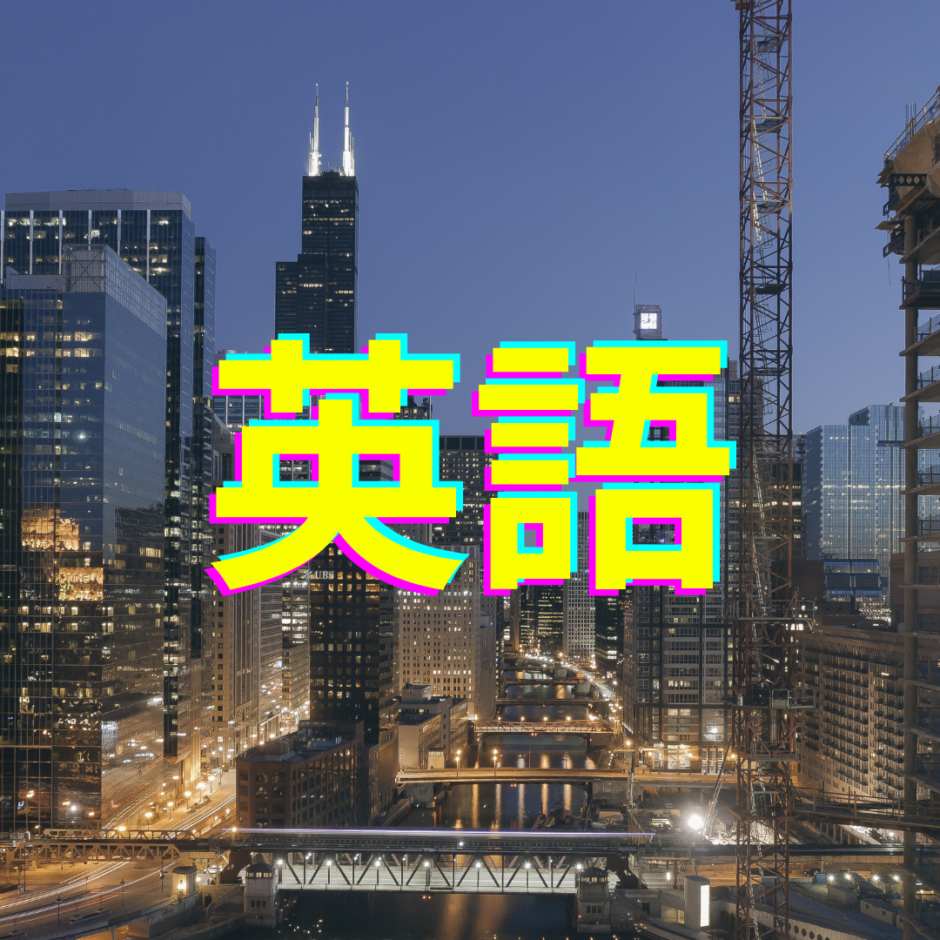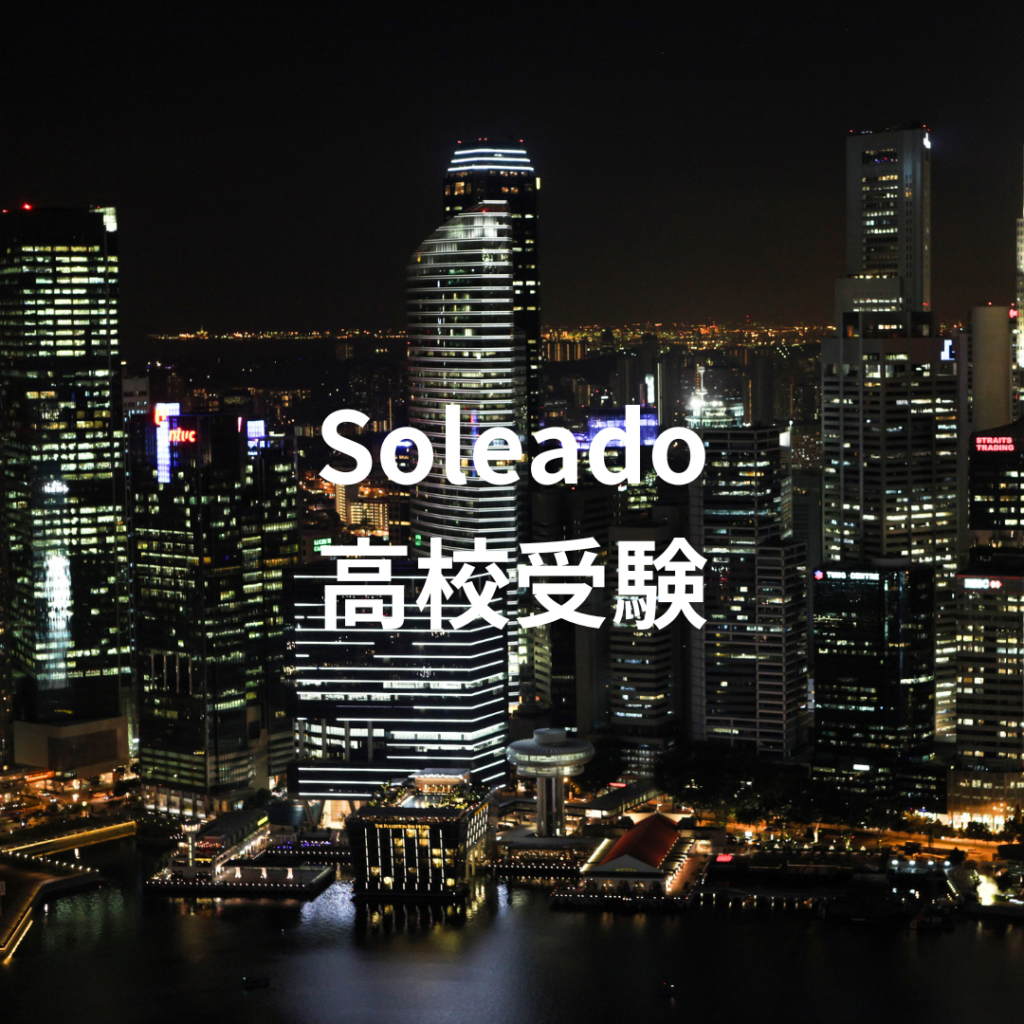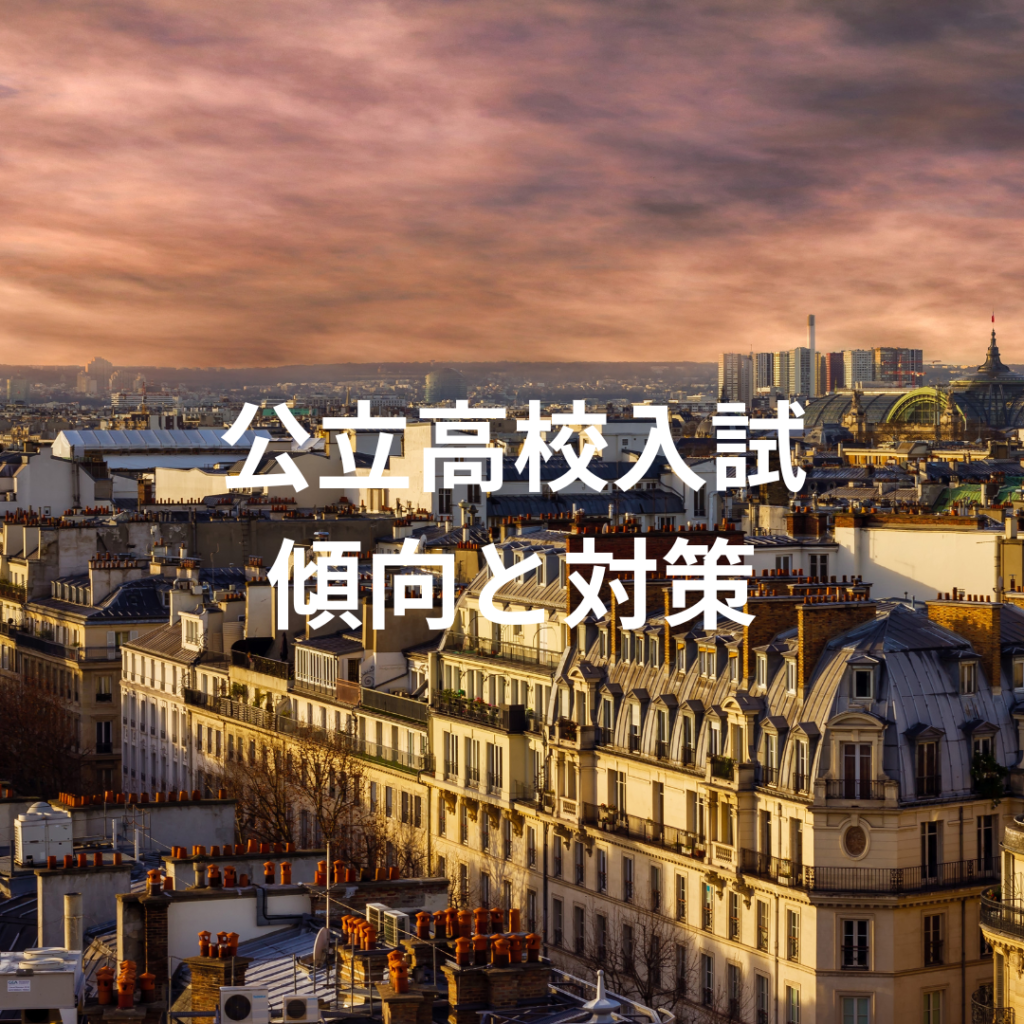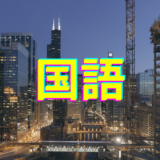最後に、傾向と対策・高校入試のしくみなどへのLINKがあります。
【1】
Choose the phrase that best completes each sentence below.
(1) Please tell ( ) help you.
ア I can do what to me
イ I can what to do me
ウ me do what to I can
エ me what I can do to
正解:●●●
(2) She was excited ( ) the national tournament.
ア the player who won to see
イ to see the player who won
ウ to the player who won see
エ won the player who see to
正解:●●●
(3) These broken things ( ) money.
ア can be repaired without much
イ can repaired without much be
ウ without much be repaired can
エ without repaired can be much
正解:●●●
(4) I wonder ( ) to get here.
ア how many hours they kept walking
イ how walking they kept many hours
ウ many hours kept how they walking
エ many hours they kept walking how
正解:●●●
(5) I( ) on a bus.
ア get many bags a person holding helped
イ get a person helped many bags holding
ウ helped a person holding many bags get
エ helped many holding bags a person get
正解:●●●
(6) The website ( ) data for my research.
ア included various useful you recommended
イ you included various useful recommended
ウ you recommended included various useful
エ various useful recommended you included
正解:●●●
【2】
Read the passage and choose the answer which best completes each blank ① and ②, and choose the best answer to the question (3).
In 2023, a report was made on a survey to see what high school students think about changes in technology such as AI. The survey was done on high school students in four countries: Japan, America, China and Korea. In each country, more than 1,800 students joined the survey. It included many questions, and, for each question, the students were asked to choose one response from 4 choices: “definitely yes,” “somewhat yes,” “somewhat no” and “definitely no.” The following graphs show the percentages of the students who chose “definitely yes” or “somewhat yes” for two of the questions.
Graph 1 shows the results of the question: “Do you think that the importance of human relationships will stay the same even if technology changes?” To this question, ( ① )in all of the four countries chose “definitely yes” or “somewhat yes.” Among the four countries, the percentage of the students who chose “definitely yes” or “somewhat yes” to the question was the highest in ( ② ). Graph 2 shows the results of the question: “Are you worried about changes in technology?” The percentages of the students who chose “definitely yes” or “somewhat yes” to the question were between 50 percent and 60 percent in all of the four countries; and the percentage of the students who chose those two responses was lower in Japan than the percentages of the students who chose those two responses in America and Korea.
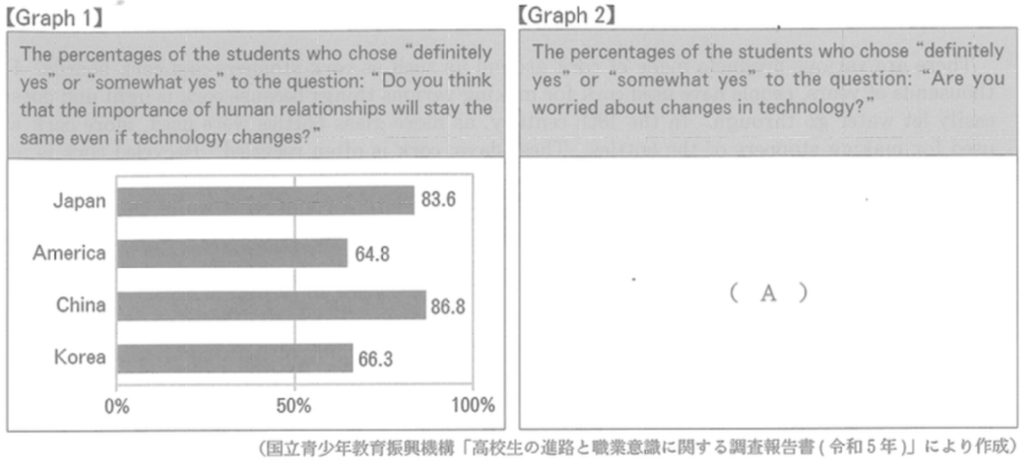
〔注〕
definitely 明確に、はっきりと
importance 大切さ
somewhat やや
graph グラフ
human relationship 人と人とのつながり
(1)①
ア less than half of the students
イ 83.6 percent of the students
ウ only a quarter of the students
エ more than 60 percent of the students
正解:●●●
(2)②
ア Japan
イ America
ウ China
エ Korea
正解:●●●
(3)Which graph should be put in ( A ) ?
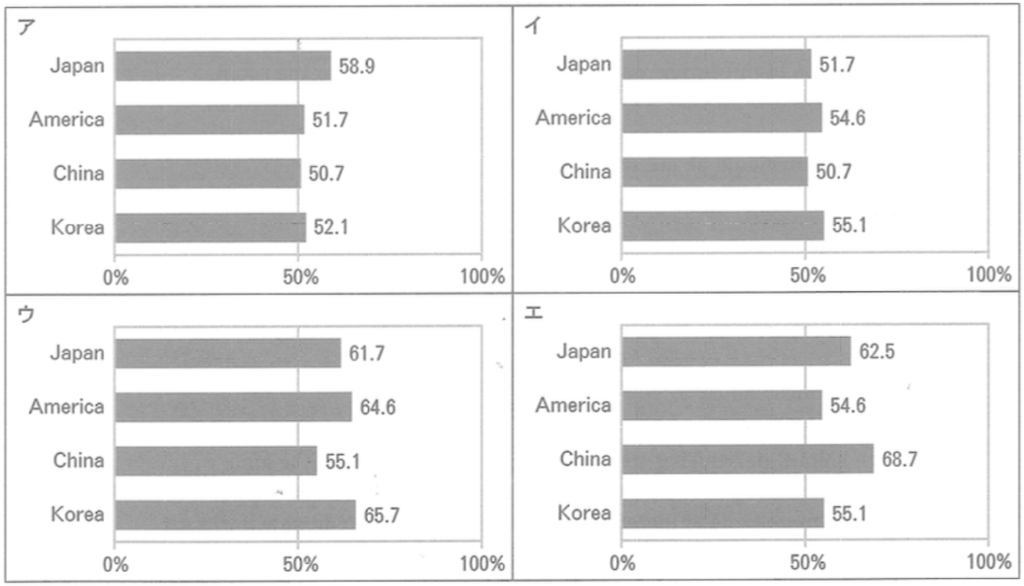
正解:●●●
【3】
Read the passage and choose the answer which best completes each sentence (1) ~ (5).
There are various products made of cork around us such as cork stoppers and cork boards. For thousands of years, people have used cork for making various things because cork is light and doesn’t easily let water go through. In the 18th century, as more glass bottles were used, more cork was used for making stoppers of the bottles. These days, cork is often recycled. Recycled cork is used for walls of buildings because walls using cork don’t easily let heat go through. Even if the temperature outside becomes very high, the temperature in a room with walls using cork isn’t affected a lot. Many people know that cork is a ( ① )material because it can be recycled, and now it is getting attention for more reasons.
Cork comes from the bark of cork oak trees. These trees grow in forests in a part of Europe and a part of Africa. You may think that, when people harvest the bark, they cut down the trees.However, the bark can be harvested without doing so. After the bark is harvested, new bark is made. People can harvest the bark of one cork oak tree about 15 to 18 times while the tree is living, and cork oak trees live for about 200 years. For these many years, cork oak trees can be a good home for various animals including some endangered birds and can support the diversity of species in forests. Also, when cork oak trees make new bark, the amount of carbon dioxide they take in from the air greatly increases. That means the trees ( ② ).Now, many companies pay attention to this eco-friendly material and its excellent features, and they use it to make even some parts of space ships.
〔注〕
cork コルク材
stopper 栓
bark 皮
cork oak tree コルク種の木
endangered 絶滅の危機にさらされた
take in 取り入れる
heat 熱
harvest 採取する
carbon dioxide 二酸化嵗素
(1) The temperature in a room with walls using cork
ア is easily influenced by the temperature outside.
イ doesn’t change a lot even if it gets very hot outside.
ウ is always high because walls using cork let heat go into the room.
エ is always low because walls using cork let heat go out of the room.
正解:●●●
(2) The word which should be put in ( ① ) is
ア medical.
イ narrow.
ウ social.
エ sustainable.
正解:●●●
(3) People can harvest the bark of a cork oak tree
ア by cutting down the tree.
イ without cutting down the tree.
ウ about 15 to 18 times every year.
エ 200 times while the tree is living.
正解:●●●
(4) The phrase which should be put in ( ② )is
ア always take in the same amount of carbon dioxide from the air.
イ are helpful in reducing the amount of carbon dioxide in the air.
ウ have no chance to take in carbon dioxide from the air.
エ play a major role in increasing the amount of carbon dioxide in the air.
正解:●●●
(5) According to the passage,
ア people first started to use cork to make things in the 18th century.
イ cork houses built for endangered animals are supporting their lives.
ウ cork is the bark of a specific kind of tree which can be seen in a part of Europe and a part of Africa.
エ many companies have started using other materials instead of cork to protect the environment.
正解:●●●
【4】
Read the passage and choose the answer which best completes each sentence (1)~(5).
Many people may not know what “Kazusabori” is. It is a method for digging a deep well safely.The method was developed in the Kazusa area in Japan in the late 19th century. In the area, it was difficult to get water from rivers, so people dug wells. Each well had to be deep enough to reach water under the ground. At first, people dug a well by working inside a hole. However, that way was dangerous. Also, they couldn’t dig a deep well in that way. So, they tried many different ways.And finally they were successful in digging a deep well safely by using some tools they created.( A )The long stick was made of bamboo and it had an iron part at the bottom. By moving the long stick outside the hole, people broke rocks in the hole without working inside. ( B ) As the hole became ‘ deeper, they made the stick longer. ( C ) Another tool was created to move the long stick without using much power.( D ) They also created a tool which helped them remove broken pieces of rocks out of the hole. With these tools, people could safely dig a well which was a few hundred meters deep. People used not only bamboo but also other materials around them to make these tools. The method of digging a well with these tools was ( ① ) to many areas in Japan. People in those areas started to call the method Kazusabori and used it until people there started to use machines.
About one century later, Kazusabori was introduced in some areas in the world as a method for digging a well without using a machine. In those areas, some people had to walk to a river to get water and then walk back with heavy water. In 1981, people started to dig wells with Kazusabori in one Asian country. Wells completed in some schools helped children get water easily. Later, Kazusabori was introduced in one country in Africa, too. However, people there couldn’t get bamboo.So, they used the idea of Kazusabori and made similar tools for digging a well by using things they could easily get there. Finally, they completed some wells by using Athese tools. The number of wells in Asia and Africa increased little by little, and now more people are able to get water easily.There are still serious water problems in the world. Kazusabori is helping people solve them.
〔注〕
Kazusabori 上総掘り(上総地方(現在の千葉県中央部)に伝わる井戸掘りの方式)
dig 掘る(過去形はdug)
well 井戸
the Kazusa area 上総地方
bamboo 竹
safely 安全に
iron 鉄
(1) People in the Kazusa area tried many different ways to
ア dig a deep well safely.
イ dig wells all over Japan.
ウ find a safe way for working in rivers.
エ go to rivers.
正解:●●●
(2) The sentence “One of them was a long stick used to make a deep hole.” should be put in
ア A
イ B
ウ C
エ D
正解:●●●
(3) The word which should be put in ( ① ) is .
ア joined.
イ returned.
ウ spread.
エ worn.
正解:●●●
4) The phrase Athese tools refers to
ア the tools made of bamboo.
イ the tools made in the Kazusa area.
ウ the tools people in an Asian country made without using the idea of Kazusabori.
エ the tools people in a country in Africa made with things they could easily get there.
正解:●●●
(5) According to the passage,
ア people in the Kazusa area used only bamboo to make all the tools for digging a well.”
イ Kazusabori was introduced in some areas in the world in the late 19th century.
ウ people in one Asian country couldn’t start to dig wells in 1981 because they didn’t have machines for digging a well.
エ thanks to Kazusabori, people in some areas in the world can get water easily.
正解:●●●
【5】
Read the passage and choose the answer which best completes each sentence (1), (2), (4), (5) and (6), and choose the answer to the question (3).
Today, if people visit a planetarium, they can learn the positions and movements of celestial bodies.Many planetariums today show those things with machines using high technology. This type of modern planetarium was born in Germany at the beginning of the 20th century. ( ① ) that type of modern planetarium was made, in the late 18th century, a man in the Netherlands tried to show the positions and movements of celestial bodies in a different way. The man’s name is Eise Eisinga.After graduating from elementary school, he didn’t continue to study in school, but he kept studying math and science by himself. He was especially interested in celestial bodies.
In 1774, when he was 30 years old, a special phenomenon was seen in the sky. On May 8th, 1774, four planets and the moon were seen close together in the eastern sky at the same time. A local newspaper in the Netherlands said that the earth would be greatly damaged because of this phenomenon.When people read the newspaper, many of them believed that the things written in the newspaper were ( ② ), so they worried about the earth and their lives very much. Now, many people know that this type of phenomenon doesn’t cause any trouble to the earth or people’s lives.However, the situation was different in 1774. In those days, only a few people including Eise Eisinga had enough information on the positions and movements of the celestial bodies to understand that the phenomenon would not affect the earth. On the other hand, many other people at the time didn’t have such information.( ③ )He thought people could learn about celestial bodies with the system.
He tried many ideas and created a system to show the positions and movements of the sun and some planets. It was a system which he put on the ceiling of a room in his house. Round objects were used to show the celestial bodies. The system including those round objects was moved by only one pendulum clock set in the attic above the room. With this system, people could easily see how the celestial bodies moved by looking up. The system was not simple and he needed many things such as gears and pulleys to complete the system. Surprisingly, he made most parts for the system by himself. He even made thousands of nails used for the system. The system was designed very well. When he almost finished creating the system, some scientists visited his house to see it. They were surprised to find the system was designed very well to show the positions and movements of the celestial bodies clearly. Like this, ( ④ )before it was completed, and they were looking forward to seeing the completed system.
After seven years of hard work, he finally completed his system and called the room with the system a “planetarium.” He let people come inside and see his planetarium. His planetarium became very popular, and not only his neighbors but also people who lived far away came to see it. His hope of sharing his information about celestial bodies with others resulted in creating his planetarium to show the latest information about celestial bodies at the time. Though his planetarium was quite different from many of today’s planetariums which use high technology to show celestial bodies, his planetarium played an important role to help people understand better about celestial bodies.Eise Eisinga’s planetarium still works and accepts visitors from all over the world.
〔注〕
planetarium プラネタリウム
Eise Eisinga アイゼ・アイジンガー
ceiling 天井
attic 屋根裏
part 部品
celestial body 天体
phenomenon 現象
object 物体
gear 菌車
nail くき
the Netherlands オランダ
moon 月
pendulum clock 振り子時計
pulley 滑車
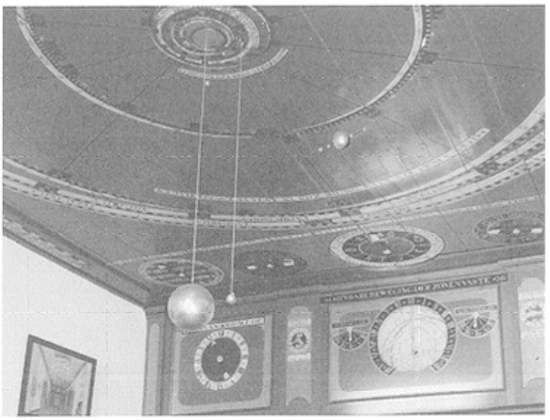
(1) The word which should be put in ( ① ) is
ア After.
イ Before.
ウ If.
エ Since.
正解:●●●
(2) The word which should be put in ( ② ) is
ア old.
イ peaceful.
ウ true.
エ wrong.
正解:●●●
(3) The following passages (i) ~ (iii) should be put in ( ③ )in the order that makes the most sense.
(i) He saw those neighbors and wanted to help them have correct information about celestial bodies.
(ii) Many of Eise Eisinga’s neighbors were also afraid that terrible things would happen to the earth because of the special phenomenon.
(iii) To do this, he decided to create a system which showed the positions and movements of some celestial bodies.
Which is the best order?
ア (ⅱ) → (i) → (ⅲ)
イ (ⅱ) → (ⅲ) → (ⅰ)
ウ (ⅲ) → (ⅰ) → (ⅱ)
エ (iii) → (ii) → (i)
正解:●●●
(4) The phrase which should be put in ( ④ ) is
ア he didn’t let people see the system.
イ many people designed the system.
ウ people were against the system.
エ the system attracted people.
正解:●●●
(5) According to the passage, the system Eise Eisinga created
ア was completed without using any nails.
イ was put on the floor of a room in his house.
ウ used round objects to show some celestial bodies.
エ used many pendulum clocks to move the objects in the system.
正解:●●●
(6) According to the passage,
ア Eise Eisinga didn’t study math and science after graduating from elementary school.
イ though Eise Eisinga never called the room with the system he created a “planetarium,” his neighbors started to call it a “planetarium.”
ウ both Eise Eisinga’s neighbors and people living far from his house visited his planetarium.
エ Eise Eisinga shared his information about the way to create planetariums with his neighbors and that led them to create planetariums with high technology.
正解:●●●
【6】
Read the following sentences and write your answer in English.
Through various experiences, people learn many things and change. Write about one of your experiences which helped you learn something important. Write what you learned from the experience, and after that, write how you changed through the experience.
回答例:●●●
大阪府教育委員会のホームページより、最新の情報が得られます。必要に応じて、見るようにしましょう!
